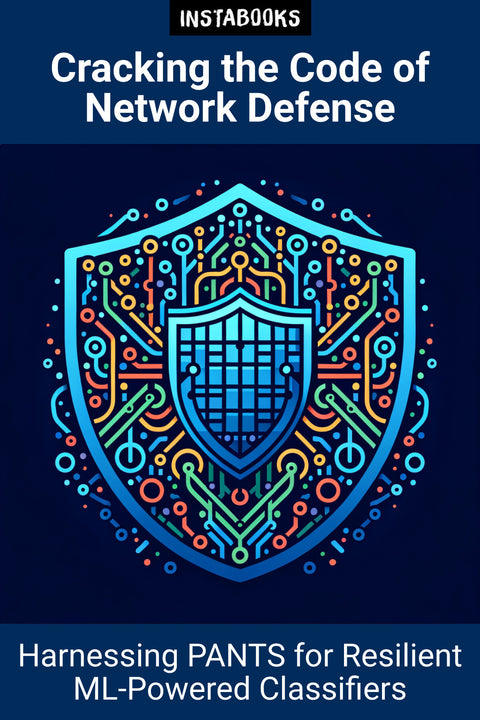
Cracking the Code of Network Defense
Harnessing PANTS for Resilient ML-Powered Classifiers
Included:
✓ 200+ Page AI-Generated Book
✓ ePub eBook File — read on Kindle & Apple Books
✓ PDF Print File (Easy Printing)
✓ Word DOCX File (Easy Editing)
✓ Hi-Res Print-Ready Book Cover (No Logo Watermark)
✓ Full Commercial Use Rights — keep 100% of royalties
✓ Publish under your own Author Name
✓ Sell on Amazon KDP, IngramSpark, Lulu, Blurb & Gumroad to millions of readers worldwide
Introduction to the PANTS Framework
In the ever-evolving world of cybersecurity, staying ahead of adversarial threats is crucial. "Cracking the Code of Network Defense" brings to light the innovative PANTS framework—a method designed to enhance the robustness of ML-powered networking classifiers against adversarial attacks. With cyber threats becoming increasingly sophisticated, understanding the nuances of adversarial traffic generation and its impact on machine learning models is more important than ever.
The Core of PANTS: Adversarial Traffic Generation
Adversarial traffic generation poses significant challenges, especially when it requires deceiving MLM-based classifiers while maintaining semantic realism. PANTS innovatively addresses these challenges by integrating traditional adversarial machine learning (AML) techniques with Satisfiability Modulo Theories (SMT) solvers. This unique approach ensures that generated adversarial samples are both practical and efficacious, bridging the gap between academic theories and real-world applications.
Enhancing ML Classifier Robustness
With PANTS, network operators can embed adversarial training processes to significantly bolster the robustness of their ML-powered systems. The framework's ability to improve robustness by over 52% without sacrificing classification accuracy showcases its pioneering edge. This book delves into how PANTS outperforms prominent baselines like Amoeba and BAP, thus advancing the state-of-the-art in adversarial defense.
Realistic Threat Simulations
PANTS doesn’t just stop at theoretical implementations. Its efficacy shines through by simulating a range of threat models including whitebox, blackbox, and restricted-blackbox scenarios. The framework’s adaptability is evident in its high success rates against ML-based Network Intrusion Detection Systems (NIDS), providing network managers with a toolkit to preemptively secure their systems against potential breaches.
Applications in Modern Cybersecurity
The potential applications of PANTS are vast and transformative. Beyond generating adversarial samples, the framework acts as a litmus test for network defenses, enabling proactive identification and patching of vulnerabilities. It equips network operators with insights crucial for robust network management tasks such as resource allocation, load balancing, and intrusion detection. Through comprehensive examples and practical guidance, this book empowers readers to leverage PANTS for securing their digital frontiers robustly.
Table of Contents
1. Understanding Adversarial Traffic- The Art of Deception
- AML Techniques and Challenges
- Realism in Traffic Samples
2. The Role of SMT Solvers
- Introduction to SMT
- Integration with AML
- Enhancing Realism
3. Iterative Adversarial Training
- Embedding PANTS
- Boosting Robustness
- Comparison with Baselines
4. Threat Models Explored
- Whitebox Scenarios
- Blackbox Challenges
- Restricted-Blackbox Dynamics
5. Evaluating ML Classifiers
- Metrics of Success
- Robustness Over Accuracy
- Case Studies of Improvement
6. PANTS in Action
- Real-World Applications
- Network Management
- Intrusion Detection Enhancement
7. Comparative Analysis
- PANTS vs Amoeba
- BAP and Beyond
- Choosing the Right Framework
8. Cyber Defense Strategies
- Understanding Threat Landscapes
- Preemptive Security Measures
- Adaptive Network Defense
9. The Future of Adversarial Networks
- Emerging Trends
- Innovations in Cybersecurity
- Predictive Threat Models
10. Case Studies and Insights
- Success Stories
- Learning from Failures
- Practical Implementations
11. Community and Ethical Considerations
- Ethical Hacking
- Collaborative Defense Efforts
- Regulatory and Legal Aspects
12. Conclusion and Next Steps
- Summarizing Key Insights
- Future Research Directions
- Call to Action for Practitioners
Target Audience
This book is written for cybersecurity professionals, network engineers, and researchers interested in enhancing the robustness of ML-powered network classifiers against adversarial attacks.
Key Takeaways
- Explore the PANTS framework for generating adversarial network traffic samples.
- Understand how SMT solvers enhance AML techniques for realistic threat simulations.
- Learn methods to bolster the robustness of ML-powered networking classifiers.
- Gain insights into different threat models, including whitebox and blackbox scenarios.
- Discover practical applications in network management and intrusion detection.
